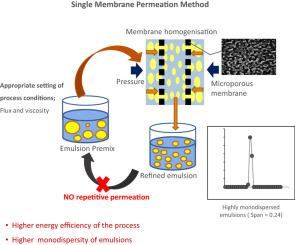Colloids and Surfaces A: Physicochemical and Engineering Aspects ( IF 5.2 ) Pub Date : 2021-09-17 , DOI: 10.1016/j.colsurfa.2021.127560 Jophous Mugabi 1 , Jae-Ho Jeong 1 , Noriyuki Igura 2 , Mitsuya Shimoda 2

|
A method for preparing emulsions with a narrow droplet size distribution (span) without repetitive membrane permeation, by controlling the premix emulsion viscosity and membrane permeation rate (MPR), flux, was provided. The mean emulsion viscosity and the MPR are some of the main factors that control the wall shear stresses responsible for droplet break up in premix membrane emulsification (PME). Hence, striking a balance between these two factors is important for preparing monodispersed emulsions.
When the emulsion viscosity and the viscosity ratio of the phase were low, the emulsion droplet size and polydispersity decreased linearly with PMR until MPR of 60 m3/m2h at which the most monodispersed emulsions (d50 =5.80, span = 0.24) were prepared. Beyond this the droplet size decreased further while polydispersity became higher, due to the uncontrolled wall shear stresses at higher MPR. Increasing the disperse phase viscosity (i.e., high viscosity ratio) lowered the shear stresses in the pores that the emulsion droplet size polydispersity became higher. Whereas, increasing the mean emulsion viscosity enabled us achieve the most monodispersed emulsions (d50 =5.80, span = 0.24) at lower MPR of 10 m3/m2 h. At low MPR the wall shear force could be increased by increasing the mean emulsion viscosity and emulsions with a small span could be prepared. Therefore, in this study it was proved possible to prepare highly monodispersed emulsions by adjusting the mean emulsion viscosity and MPR, without repetitive permeation, in PME.
中文翻译:

通过不重复渗透的预混膜乳化制备单分散乳液:膜渗透率(通量)和乳液粘度的影响
提供了一种通过控制预混乳液粘度和膜渗透速率 (MPR)、通量来制备具有窄液滴尺寸分布(跨度)而无需重复膜渗透的乳液的方法。平均乳液粘度和 MPR 是控制导致预混膜乳化 (PME) 中液滴破裂的壁面剪切应力的一些主要因素。因此,在这两个因素之间取得平衡对于制备单分散乳液很重要。
当乳液粘度和相的粘度比较低时,乳液液滴尺寸和多分散性随 PMR 线性下降,直至 MPR 为 60 m 3 /m 2 h,此时大多数单分散乳液(d 50 =5.80,跨度 = 0.24)准备好了。除此之外,由于在较高 MPR 下不受控制的壁剪切应力,液滴尺寸进一步减小,而多分散性变得更高。增加分散相粘度(即高粘度比)降低了孔中的剪切应力,从而使乳液液滴尺寸多分散性变得更高。然而,增加平均乳液粘度使我们能够在10 m 3 /m 的较低 MPR 下获得最单分散的乳液(d 50 =5.80,跨度 = 0.24)2小时。在低 MPR 下,可以通过增加平均乳液粘度来增加壁面剪切力,并且可以制备小跨度的乳液。因此,在这项研究中,证明可以通过调节平均乳液粘度和 MPR 来制备高度单分散的乳液,而无需在 PME 中重复渗透。



























 京公网安备 11010802027423号
京公网安备 11010802027423号